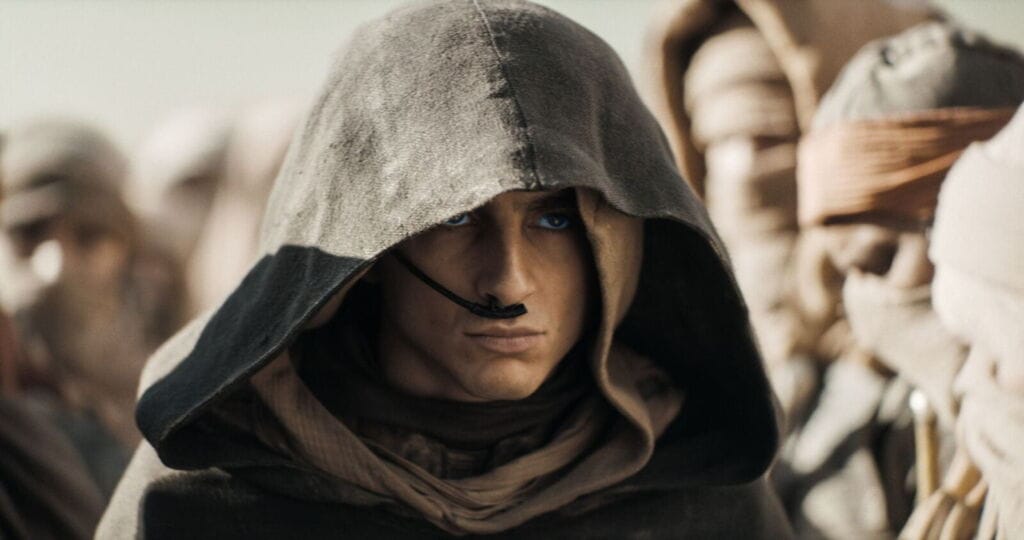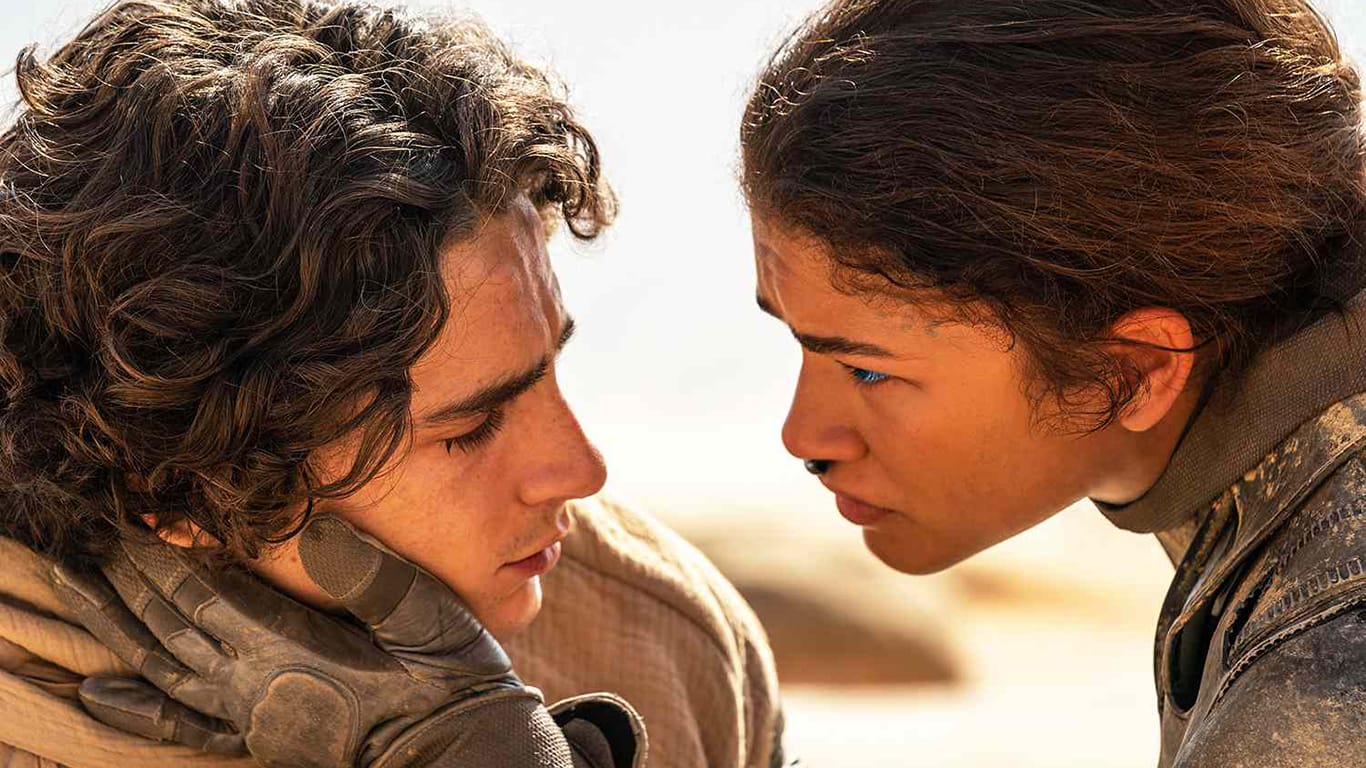Dune: Part Two begins just like Part One: alien throat singing piercing the darkness before the studio logos appear. It surprised me the first time, and it also did the second time, because much of Part One had vanished from my mind in the last two and a half years. It’s an impressive film, daunting in scale and potential, but its subtext felt as incomplete as its narrative—a syllabus for a course yet to play out. We’ll unpack holy wars and space messiahs when the semester really starts. I haven’t read Herbert’s Dune, so I was eager to see how its themes would cohere in the second of two parts adapting it. That was maybe too optimistic for a franchise with a spinoff show in development, but what can I say? I’m a dreamer.
READ ALSO: Read all of Ryan Bordow’s movie reviews here
To both Part One and Two’s credit, director Denis Villeneuve and his team of writers found a great spot to bisect the book, as Part Two opens in fertile ground for resetting the story’s momentum. The Fremen, Arrakis’ imperialized indigenous spice-infused warriors, have taken Paul Atreides into their ranks as one of their own. Some Fremen believe Paul their prophesized savior, the Lisan al Gaib, who will defeat the invading Harkonnen and the Empire that enables them. Others, like Paul’s burgeoning love interest Chani, are skeptical. And pulling every string is Paul’s mother Jessica, a Lady of the Bene Gesserit—essentially the space Illuminati—who has a vested obsession with Paul accepting the messiah mantle. Like if Mary, mother of Jesus were a lot more overbearing.
Part Two runs with these dynamics from its opening minutes. Paul seems generally aligned with his mother’s machinations so long as they end in peace for Arrakis—“I must sway the non-believers,” says Timothée Chalamet, dryly—but he’s more reluctant than her to declare himself a savior. Instead he presents himself as the ultimate ally, conceding that he’s an outsider but promising “to learn and be better” (almost a direct quote). His humility only persuades the Fremen further of his divinity, but Chani remains unswayed: “You want to control people? Tell them a Messiah will come,” she muses. “Then they’ll wait for centuries.” She grows more uncomfortable when she hears Lady Jessica’s plan: journey to the south, where Fremen fundamentalists are clamoring for a savior, and arm the extremists for holy war. (Herbert’s novel uses a term the film elides—“jihad.”)

Not too long into Part Two and its thematic doors are wide open. The propensity of the oppressed to self-fulfill a prophecy, the exploitation of faith on the imperial stage, the liberatory yet destructive potential of those rallying under a messiah—these are bedrocks of Abrahamic religions that have defined our world for millennia. There’s so much here, and the story adds some challenging layers: the leader of the jihad is a white guy, so are we provocatively subverting the white savior narrative? Or are we so far removed from jihad’s essential specificities that we’re saying little of cultural value? Whether or not the film fails, it’ll be at the very least interesting.
Or so went my optimistic thinking. Even condensing half the novel, Part Two feels like it’s skimming. The story can change gears with jarring immediacy: the Fremen’s acceptance of Paul, the turning of the tide in the war, and crucially, shifts in Paul’s motivations and outlook seem to advance out of sheer inevitability. That’s part of the point, I suppose—that powerful hands are controlling this game and the players’ decisions have long been pre-motivated—but in a vacuum of character detail, inevitability feels less like cruel destiny and more like dull resignation. Like watching a political time-lapse map of dynasties from thousands of years ago. A passionless kiss between Chani and Paul doesn’t give the story human color, and neither does MCU-esque chumming around between Paul and his underdeveloped friends.
What would it feel like to be spotlighted in the mire of this political and religious conflict? I still don’t know (and apparently neither does Chalamet, who after Part Two seems all the more clearly miscast). Paul remains a cipher, his character shifts prefigured but rarely seen in action. I found myself imagining the gut-wrenching reckoning he must’ve been doing off-screen. The overriding feeling I got from Part Two was exactly what I got from Part One: wanting to read the book to get the real depth. I’ve heard it’s there, and I still want to see it.
Beyond the subtext, what we literally see in Dune: Part Two is undeniably awe-inspiring. Villeneuve shoots Arrakis with disorienting naturalism, avoiding more obviously stylized weirdness for something more deeply alien: filming a space war like it’s a nature documentary. Monochromatic palettes of endless harsh terrain; bodies dropping down an impossibly sheer cliff face; sleek, brutish architecture shot in black and chrome; all these in wide, quiet shots, vignetted by an emptiness both strange and estranging. And Villeneuve knows exactly how machinery should fill the frame—every vehicle a massive, unnatural monster. The film grazed my emotions in its cinematic overwhelm, particularly in how it pictures religious visions, with deep, rich colors, pulsating noise and ever-pregnant symbolism. It also knows the visual power of a cloak billowing in the wind, which, of course, is tremendous.
But it feels like a tourist in its own themes. And given the ongoing genocide in Palestine, its Arab cultural coding is almost cowardly shallow. I’m not sure a movie this thin should be the Hollywood poster boy for Arab revolution, but its production design and score—the latter with all its ululating—invite the label at every turn. Still, the ending is very much another lead-in to a sequel, so maybe the novel’s themes and real-life analogues will finally cohere in Dune Messiah. What can I say? I’m a dreamer.
★★★ (3/5)




